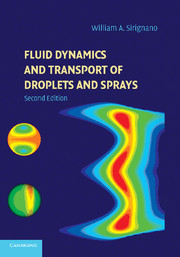Book contents
- Frontmatter
- Contents
- Preface
- Nomenclature
- 1 Introduction
- 2 Isolated Spherically Symmetric Droplet Vaporization and Heating
- 3 Convective Droplet Vaporization, Heating, and Acceleration
- 4 Multicomponent-Liquid Droplets
- 5 Droplet Behavior under Near-Critical, Transcritical, and Supercritical Conditions
- 6 Droplet Arrays and Groups
- 7 Spray Equations
- 8 Computational Issues
- 9 Spray Applications
- 10 Spray Interactions with Turbulence and Vortical Structures
- 11 Film Vaporization
- 12 Stability of Liquid Streams
- Appendix A The Field Equations
- Appendix B Conserved Scalars
- Appendix C Droplet-Model Summary
- Bibliography
- Index
Appendix B - Conserved Scalars
Published online by Cambridge University Press: 05 June 2012
- Frontmatter
- Contents
- Preface
- Nomenclature
- 1 Introduction
- 2 Isolated Spherically Symmetric Droplet Vaporization and Heating
- 3 Convective Droplet Vaporization, Heating, and Acceleration
- 4 Multicomponent-Liquid Droplets
- 5 Droplet Behavior under Near-Critical, Transcritical, and Supercritical Conditions
- 6 Droplet Arrays and Groups
- 7 Spray Equations
- 8 Computational Issues
- 9 Spray Applications
- 10 Spray Interactions with Turbulence and Vortical Structures
- 11 Film Vaporization
- 12 Stability of Liquid Streams
- Appendix A The Field Equations
- Appendix B Conserved Scalars
- Appendix C Droplet-Model Summary
- Bibliography
- Index
Summary
Consider the gas phase that surrounds or adjoins liquid droplets, films, pools, and/or streams. Figure B.1 presents a diagram that portrays a wide variety of two-phase reacting flow situations included here. Laminar multicomponent flow with viscosity, Fourier heat conduction, and Fickian mass diffusion will be analyzed. Diffusivities for all species will be assumed identical; the Lewis number value will be unity; radiation will be neglected; and kinetic energy will be neglected in comparison with thermal energy so that, with regard to the energetics, pressure will be considered uniform over the space although the pressure gradient can be significant in the momentum balance (small Mach number). We will analyze, as a general case, the situation in which a one-step exothermic reaction occurs between the ambient gas and the vapor from the bulk liquid. We will refer to the liquid as the fuel and the ambient gas as the oxidizer, although the opposite situation, e.g., oxygen droplet in hydrogen gas, can be analyzed in exactly the same fashion. The nonreacting case can be the special subcase in which the reaction rate becomes zero.
Both steady and unsteady scenarios will be discussed. The roles of the gas-phase energy equation and the species equations will be emphasized. Of course, they must be coupled with the continuity and momentum equations and with a gas equation of state. In addition, the solution of conservation equations for the liquid phase might be required.
- Type
- Chapter
- Information
- Fluid Dynamics and Transport of Droplets and Sprays , pp. 415 - 421Publisher: Cambridge University PressPrint publication year: 2010

